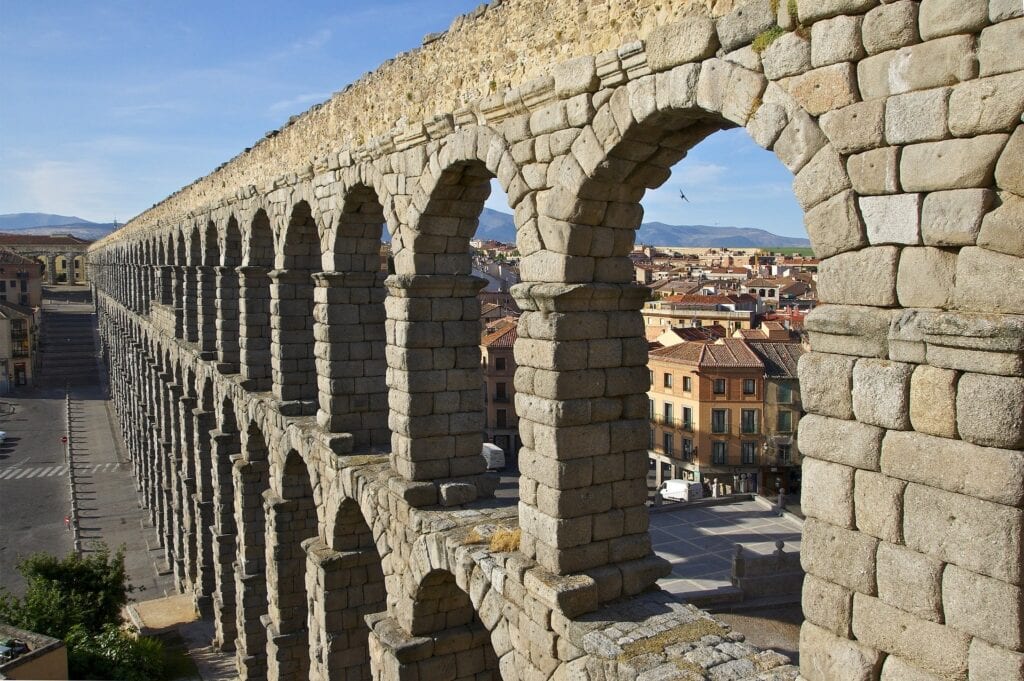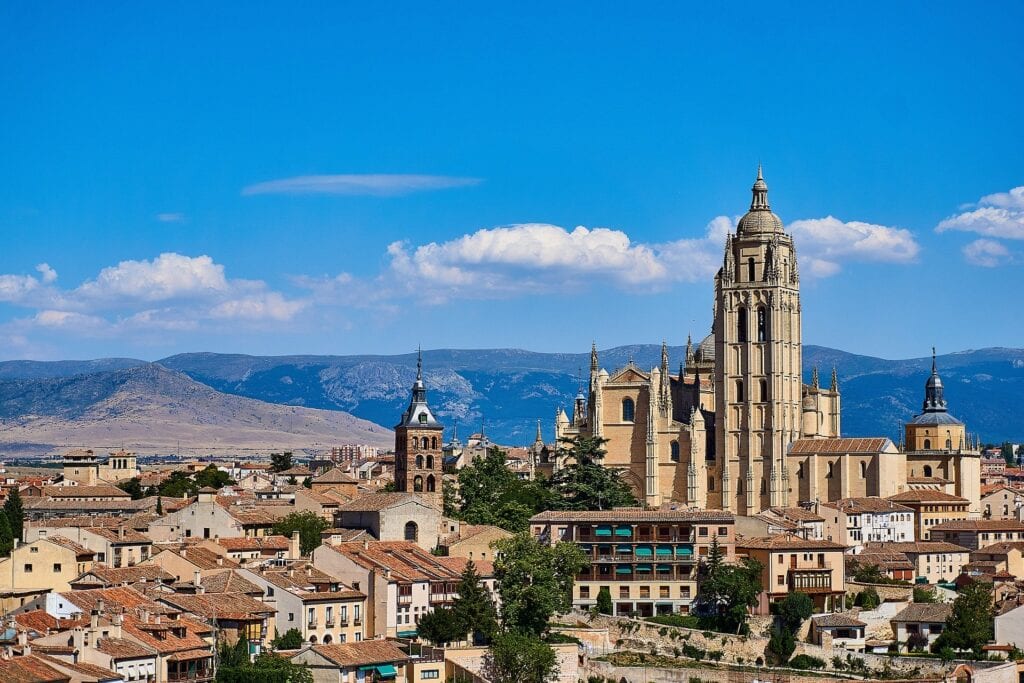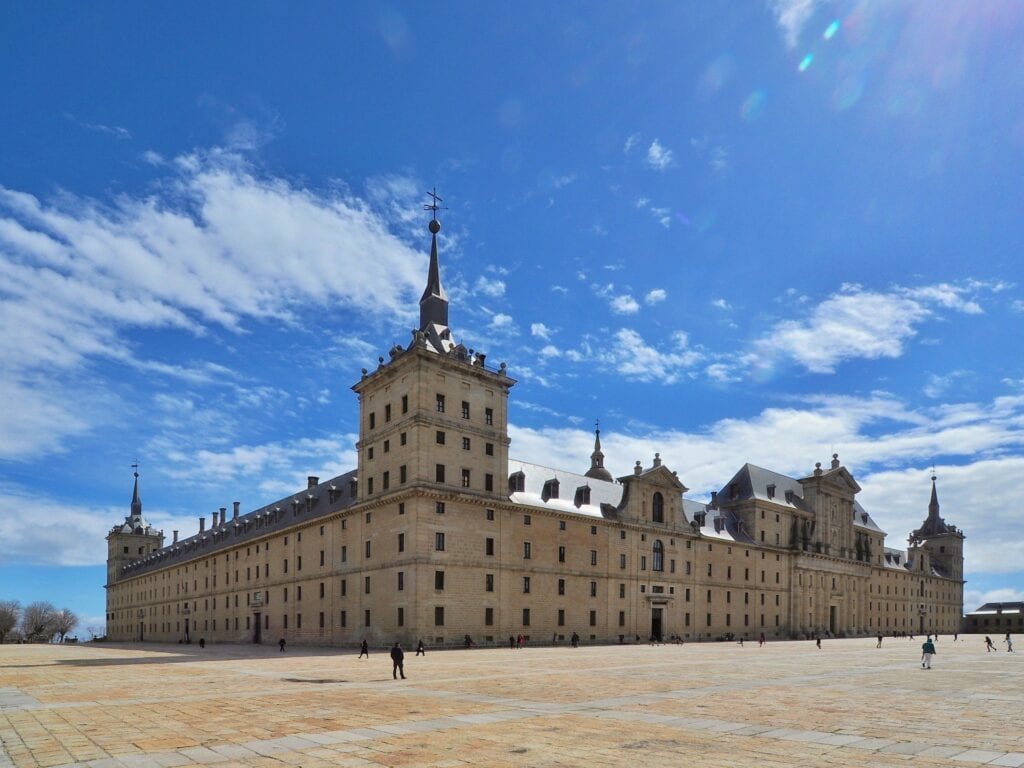Standing atop a rocky crag just 92 kilometres north-west of Madrid lies Segovia, a treasure trove of Spanish history which remains remarkably preserved despite the passage of centuries. This UNESCO World Heritage gem may be home to only 50,000 people, but it punches well above its weight in cultural significance and architectural splendour. With its fairytale Alcázar perched dramatically on a promontory, Spain’s ‘newest’ Gothic cathedral (a mere 500 years young) and a jaw-dropping Roman aqueduct which has stood the test of two millennia, the things to do in Segovia offer visitors an extraordinary journey through time.

As you approach this ancient city, its silhouette against the Castilian sky appears almost impossibly romantic – a tableau of spires, towers and terracotta rooftops which seems plucked from a medieval manuscript. Originally a Celtic settlement known as Segobriga (from the Celtic word for fortress), the Romans claimed this strategic location around 80 BC, transforming it into an imperial city of considerable importance. Later, under Moorish rule, Segovia flourished as a centre of wool production, an industry which sustained the city’s prominence well into the 16th century.
Though it later retreated into something of a genteel backwater, beloved by Spanish royalty as a hunting retreat, Segovia’s fortunes were revived when UNESCO recognised its extraordinary historical significance in 1985. Today, exploring the many things to do in Segovia feels like stepping into a living museum where every corner reveals another architectural wonder or culinary delight. Whether you’re sampling the city’s renowned suckling pig, marvelling at the 167 arches of the aqueduct, or watching the sunset cast its golden glow over the Alcázar which reportedly inspired Walt Disney, Segovia promises an unforgettable Spanish sojourn – even if you can only visit as part of a day trip during your Madrid itinerary.
How to Get to Segovia From Madrid
Travelling from Madrid to Segovia is convenient and straightforward, with several transportation options to suit different preferences and schedules. Whether you prefer the flexibility of driving yourself, the speed of a high-speed train, or the simplicity of a direct bus service, you’ll find Segovia readily accessible for day trips from Madrid. Below are the main transport options for getting to Segovia:
By Train: Take the high-speed AVE service from Madrid’s Chamartin station to Segovia-Guiomar station. The journey takes only 25 minutes, though the station is 5km from the city centre. Buses and taxis are available on arrival. Alternatively, slower regional trains depart from Atocha station, taking about 2 hours.
By Bus: Avanzabus operates comfortable services from Madrid’s Moncloa bus station, departing every 30 minutes. The journey takes about 1¼ hours. Buses arrive at Paseo de Ezequiel Gonzalez, a short walk from the Roman aqueduct and main attractions.
By Car: Take the A-6 northwest from Madrid, which becomes the AP-6 toll road beyond Collado Villalba. Look for signs to Segovia on the AP-61 after San Rafael. Total journey is about 90km and takes approximately 1¼ hours.
Organised Tours: Day trips to Segovia are popular excursions from Madrid, often combined with visits to the likes of Ávila, El Escorial and Valle de los Caídos.
For more information, take a look at our post describing the Best Ways to Travel to Segovia from Madrid.






Places to Visit on the Way to Segovia
If you’re driving or joining an organised tour, you can enhance your Madrid to Segovia day trip with stops at other significant sites. Ávila, the birthplace of St. Teresa, is renowned for its imposing medieval walls and spiritual heritage. El Escorial, Philip II’s grand monastery-palace, offers a glimpse into Spain’s imperial past with its stunning architecture and royal tombs.
Nearby, the Valley of Cuelgamuros (formerly Valle de los Caídos) features a vast basilica carved into the mountainside and a towering cross. Originally built under Franco’s regime, it now serves as a site of historical memory, commemorating those who died in the Spanish Civil War. These stops provide a deeper cultural and historical context before arriving in Segovia.
San Lorenzo de El Escorial
This UNESCO World Heritage site features the immense Royal Monastery built by King Philip II in the 16th century, housing a palace, basilica, library and pantheon where many Spanish monarchs are entombed. The architectural harmony of this austere yet imposing complex reflects the Spanish Golden Age and offers insight into Philip II’s powerful reign. The monastery’s library contains over 40,000 precious volumes and the basilica features masterpieces by Italian and Spanish artists.

Ávila
Ávila is another UNESCO World Heritage site which lies just 68km west of Segovia. This perfectly preserved medieval city is encircled by impressive 11th-century walls with 88 towers and nine gates. Ávila is closely associated with Saint Teresa, the 16th-century mystic and reformer, whose presence is felt throughout the city’s numerous religious buildings. The cathedral, which dates back to the 12th century, blends Romanesque and Gothic styles and doubles as part of the city’s defensive walls.

Valle de Cuelgamuros (Valle de los Caídos)
The Valley of the Fallen presents a more controversial but historically significant monument. This enormous memorial, topped by the world’s tallest memorial cross at 150 metres, was built between 1940 and 1958. Originally constructed to honor those who died during the Spanish Civil War, its massive basilica carved into the mountainside creates a somber atmosphere. Since 2022 the site has officially been known as Valley of Cuelgamuros.
Things to Do in Segovia
Roman Aqueduct of Segovia
The magnificent Roman Aqueduct stands as Segovia’s most impressive monument and one of the best-preserved ancient structures in all of Europe. Constructed around the late 1st or early 2nd century AD, this engineering marvel transported water from the Río Frío in the Sierra de Guadarrama mountains approximately 17km to the city. The most spectacular section of this UNESCO World Heritage monument is the elevated portion that enters the city, consisting of a double tier of arches built without mortar.

The structure comprises:
- 167 arches supported by 120 pillars.
- 20,400 precisely cut granite blocks held together solely by perfect balance.
- A total length of 813 metres.
- A maximum height of 28.5 metres.
What makes the aqueduct particularly remarkable is its ingenious construction technique using precisely cut granite blocks assembled without mortar or clamps, relying entirely on the perfect balance of forces. Despite nearly two millennia of earthquakes, storms and urban development, the structure remains largely intact and continued supplying water to Segovia well into the 20th century.
The aqueduct became such an iconic symbol of Segovia that it appeared as the mintmark on all coins produced at the Royal Mint of Segovia from 1455 until the mint ceased operations in 1868. Today, the Plaza del Azoguejo beneath the tallest arches serves as a vibrant gathering place, allowing visitors to appreciate the monumental scale and exceptional craftsmanship of this ancient Roman achievement.
Alcázar of Segovia
Standing on a rocky outcrop at the city’s western edge, the Alcázar de Segovia is one of the city’s main tourist attractions. This medieval fortress-palace, begun in the early 12th century on Roman and Arab foundations, blends military might with royal elegance. Over centuries, Castilian monarchs transformed it into a lavish residence, crowned by its signature slate-covered conical towers – added in the 16th century under Philip II – giving it a fairytale charm often linked to Disney’s Sleeping Beauty Castle.

A fire in 1862 damaged much of the interior, but it was faithfully rebuilt. Highlights include the Torre de Juan II, offering great views of Segovia and the Guadarrama mountains; the Sala de Reyes, with a royal frieze; and the Sala de las Piñas, known for its unique pinecone-decorated ceiling.
Once a royal seat, it later served as the Royal Artillery School and now houses a military museum alongside its ornate state rooms. Easily accessible in Segovia’s compact UNESCO-listed centre, the Alcázar offers a quick dive into history, architecture and breathtaking vistas. Arrive early to beat the crowds and wear comfortable shoes for the tower climb!
Cathedral of Segovia
The Cathedral of Segovia, built between 1525 and 1577, is one of Spain’s last great Gothic cathedrals and is often called La Dama de las Catedrales (The Lady of All Cathedrals) due to its elegance. Dominating the Plaza Mayor, this majestic structure features soaring vaulted ceilings, intricate stained glass and an impressive late-Gothic cloister. Highlights include the finely carved choir stalls, a collection of religious artworks and the striking Baroque main altarpiece. Visitors can also climb the bell tower for panoramic views over Segovia.

The Jewish Quarter
Segovia’s Jewish Quarter is a fascinating area filled with history and charm. This labyrinth of narrow streets was once home to a thriving Jewish community during the Middle Ages. Today, visitors can explore historic synagogues, cultural centres and museums such as the Centro Didáctico de la Judería, which provides insight into Jewish life in Segovia. Wandering through this atmospheric district offers a glimpse into the city’s multicultural past.
Church of Vera Cruz
Located slightly outside the city centre, the Church of Vera Cruz is a unique Romanesque church built in the 13th century. Believed to have been constructed by the Knights Templar, it features an unusual 12-sided design. Inside, visitors can admire its simple yet captivating architecture and its connection to medieval religious orders. The church’s hilltop location also offers stunning views of Segovia and the surrounding landscape.
Casa de los Picos
One of Segovia’s most distinctive buildings, Casa de los Picos, is a 15th-century mansion famed for its striking façade adorned with pyramid-shaped granite blocks. Now serving as an art school and exhibition space, the building’s unique exterior makes it a popular stop for visitors exploring the city’s architectural wonders.
Other Places to Visit Near Segovia
The area surrounding Segovia offers numerous opportunities to extend your exploration beyond the city itself, with historic royal residences, natural wonders and cultural landmarks all within easy reach.
La Granja de San Ildefonso
Located just 12km east of Segovia, La Granja de San Ildefonso houses a magnificent baroque palace built by Philip V beginning in 1721. Modeled after his grandfather Louis XIV’s Palace of Versailles, this royal retreat features majestic rooms adorned with an impressive collection of paintings and tapestries. However, the true highlight is undoubtedly the meticulously designed 1,500-acre gardens with their spectacular array of 26 mythologically-themed fountains.
Using only gravity to propel water – sometimes reaching heights of 40 metres as with La Fama fountain – these engineering marvels operate partially throughout the year, with full displays reserved for the feast days of San Fernando (May 30th) and San Luis (August 25th). whilst visiting, don’t miss the La Granja Royal Glass Factory, an 18th-century facility housing a permanent exhibition dedicated to traditional glassmaking techniques.
Sierra de Guadarrama National Park
This mountain range separates Madrid from the plains of Castilla y León and serves as Madrid’s primary water source, with scenic lakes and rivers complementing the impressive alpine landscapes. Rising to 2,430 metres at Peñalara peak, the Sierra features extensive pine and oak forests carpeted with thyme, Spanish bluebells and lavender. Wildlife enthusiasts might spot roe deer, wild boar, foxes, otters, badgers and occasionally wolves, whilst birdwatchers can observe black and griffon vultures, golden and Spanish Imperial eagles, goshawks, red and black kites and honey buzzards.
Hiking and outdoor activities are particularly popular in this region, especially during summer when the mountains provide welcome relief from Madrid’s intense heat. The towns of Lozoya, Miraflores, Navacerrada and Rascafria serve as excellent base camps, offering detailed maps and well-marked routes for visitors of all experience levels. The area provides opportunities for hiking, mountain biking, horseback riding and in winter, skiing at several resorts including Puerto de Navacerrada and Valdesquí.
Segovia Tourist Information
Where to Stay in Segovia
While most visitors come for a day trip, staying overnight allows you to experience the city after the day-trippers depart. Recommended accommodations include:
Hotel San Antonio el Real: A converted monastery offering elegant rooms in a National Monument with traditional Segovian cuisine.
Parador de Segovia: Located 3km from the center, it offers panoramic city views, an outdoor pool, and excellent regional cuisine.
Hotel Infanta Isabel: Occupying a prime position on Plaza Mayor with comfortable rooms and a popular café-terrace for people-watching.
Hostal Palacio San Facundo: Located within the historic centre, this beautifully renovated 16th-century palace offers sophisticated accommodations with historical charm.
Dining in Segovia
Regional Dishes
Segovia is renowned for its rich gastronomic heritage, with several must-try dishes which reflect the region’s traditions:
Cochinillo Asado (Roast Suckling Pig): The city’s most famous dish, cochinillo asado, is a succulent roast suckling pig with crispy golden skin. Traditionally, it is roasted in a wood-fired oven and served in renowned establishments such as Mesón de Cándido and Restaurante José María. This dish is deeply ingrained in Segovia’s culinary culture and is a must-try for any visitor.
Judiones de La Granja: Another local speciality, judiones de La Granja, consists of large white beans cooked with chorizo, morcilla (blood sausage) and pork. This hearty dish originates from the nearby town of La Granja and is a staple in Segovian cuisine.
Ponche Segoviano: For dessert, ponche segoviano is a delightful sweet treat. This layered sponge cake is filled with marzipan and covered in caramelised sugar, making it a favourite among locals and visitors alike.
Traditional Restaurants
Some of Segovia’s best-known restaurants include:
Mesón de Cándido stands at the foot of the aqueduct on Plaza de Azoguejo, offering magnificent views from its open-air terrace. Founded by one of Spain’s foremost chefs, this iconic establishment maintains exceptional standards and boasts over 350 Denomination of Origin wines. Advance booking is essential, especially during summer and weekends.
Restaurante José María near Plaza Mayor on Calle Cronista Lecea is another must-visit destination requiring advance reservations. Known for outstanding game dishes, traditional roasts, cochifrito (a specialty meat dish prepared with white wine and eggs) and delectable pickled wild mushrooms.
Mesón Duque on Calle Cervantes and Restaurante La Concepción with its inviting bar and terrace on Plaza Mayor are both popular choices among locals and visitors alike. For a more casual experience, Bar El Sitio on Calle Infanta Isabel, provides the perfect setting to enjoy some local tapas.
Festivals in Segovia
Segovia’s rich cultural heritage is reflected in its vibrant festival calendar, with events spanning the entire year. From age-old religious traditions to internationally acclaimed arts festivals, the city’s historic streets and monuments provide an atmospheric backdrop for celebrations that attract visitors from across the world.
The year begins with the Santa Águeda Women’s Festival in February, an empowering celebration where women take symbolic control of the city. Spring brings the Titirimundi Puppet Festival, transforming Segovia into a stage for puppeteers from around the world, while summer is filled with music, dance, and revelry. The Festival of San Juan and San Pedro in June welcomes the season with fireworks and traditional performances, followed by Folk Segovia and the prestigious International Festival of Dance and Music in July.
Autumn brings literature to the forefront with the Hay Festival Segovia, a gathering of renowned authors and thinkers, while open-air cinema screenings provide a relaxed way to enjoy the city’s warm evenings. As winter arrives, Segovia’s Christmas Market and New Year’s Eve celebrations fill the city with festive cheer. Whether drawn by history, music, or tradition, visitors will find Segovia’s festivals an unforgettable part of their experience.
FAQs About Segovia
When is the Best Time to Visit Segovia?
Segovia is a year-round destination, but spring and autumn offer the most pleasant weather. Summer can be hot and winter occasionally brings snow, which adds a magical touch to the city’s historic sights. Visiting on a weekday is advisable to avoid the weekend crowds that often flock to Segovia from Madrid.
What is the Best Way to Explore Segovia
Segovia’s compact size makes it an ideal city to explore on foot. The old town’s winding streets are filled with historic buildings, charming plazas and hidden gems waiting to be discovered. Strolling from the aqueduct to the Alcázar allows visitors to take in the city’s architectural splendour at a leisurely pace.
For a deeper understanding of Segovia’s history, guided tours offer invaluable insights. Options include walking tours led by local historians, themed tours focusing on Segovia’s Jewish heritage and even food tours showcasing the city’s culinary delights.
Beyond the historic centre, Segovia offers picturesque landscapes and walking trails. The area surrounding the Alcázar and the nearby Eresma River provide excellent routes for cycling and hiking, offering stunning views of the city and its surroundings.



